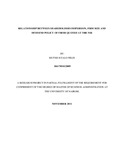| dc.description.abstract | This study analyses the relationship between the dividend payout ratio, firm size and the shareholders dispersion using sample of firms which are listed at the Nairobi Stock exchange (NSE) for the period 2005 to 2010. The study uses a sample of31 firms out of the total 55 firms listed at the NSE by December 2010. The sampled firms consistently paid dividends to the shareholders over the period of the study. The study also tested whether the DPOR of the firms listed at the NSE support various existing dividend payout policy theories. Secondary data was obtained from the NSE secretariat, internet and company financial statements. The data was analyzed appropriately and the shareholders dispersion was calculated by dividing the number of shareholders by the total shares for each company.
The average DPOR was calculated, as well as the natural log of the average market capitalization for each firm. Parametric analysis was done and regression was performed on the various variables and the findings analyzed using descriptive statistics and regression, which are also presented in tables and charts. The R2 from the regression is 23% in the estimated model coefficients, the p-values were greater than .05 at 95% confidence interval. This implies that the firm size and the shareholders dispersion do not have a significant influence to the DPOR. Hence the results suggested a stronger relationship between the shareholders dispersion and the dividend payout ratio than the market capitalization and the dividend Payout ratio.
High dividend payout ratio is a sign of higher firm value, hence the firm value is an increasing function of the dividend payout ratio. Most of the firms with high capitalization paid relatively higher dividends although this varied according to the sectors. This is an indication that the firms with low capitalization reinvested most of the earnings rather than payment of dividends to shareholders. This is evidenced by the firms under the commercial and services sector which recorded the highest growth in capitalization, however the dividend payout ratio remained relatively stable and low. The findings weakly support the agency cost theory, hence the dividend payout ratio is positively related to the dispersion of shareholders although in a weak form according to the findings of this study. | en_US |

